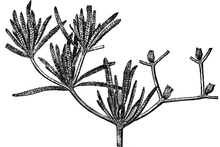Bennettitales
Cycadeoidaceae had stout, cycad-like trunks with bisporangiate (containing both megaspores and microspores) strobili (cones) serving as their reproductive structures.
One unusual leaf form, Eoginkgoites, even approaches a palmate appearance similar to early species of Ginkgo.
Cavities filled with curved synangia-bearing microsporophylls are encased by thin radiating structures, including thick, infertile interseminal scales and fertile sporophylls with ovules at their tips.
[6] Seeds are dicotyledonous (possess two embryonic leaves), with a central embryo surrounded by three layers: the thin megagametophyte, the slightly thicker nucellus, and the protective integument.
The nucellus and integument are unfused above the chalaza (base of the seed), unlike cycads or gnetophytes, where the layers are fused for much of their height.
[11] The interseminal scales of Bennettitales ovulate cones may have become fleshy at maturity, which could have potentially made then attractive to wild animals that served as seed dispersers.
[14][17] The order Bennettitales was erected by German botanist Adolf Engler in 1892, who recognised the group as separate from the Cycadales.
[18] The Anthophyte hypothesis erected by Arber and Parking in 1907[19] posited that angiosperms arose from Bennettitales, as suggested by the wood-like structures and rudimentary flowers.
[21] Molecular evidence has consistently contradicted the Anthophyte hypothesis, finding that Angiosperms are the sister group to all living gymnosperms, including Gnetales.
[22] Some authors have suggested due to similarities between their seed coats, Bennettitales form a clade with the gymnosperm orders of Gnetales and Erdtmanithecales, dubbed the "BEG group".
[26] Supposed Carboniferous-Permian records of Pterophyllum do not have conclusive bennettitalean affinities or have been reinterpreted as cycad foliage in the form genus Pseudoctenis.
[5] This formation is notable for the early occurrence of other Mesozoic-style flora, including the earliest records of corystospermalean foliage (Dicroidium).
[28] The order Fredlindiales (containing the genus Fredlindia) from the Late Triassic of Gondwana appears to be closely related to Bennettitales, but differs from it in some aspects of its reproductive organs.
[16] The bennettitalean fossil record reappeared in the Middle Triassic, and williamsoniaceans became globally distributed by the end of the period.
[29][5] The oldest bennettitalean reproductive structures are small Williamsonia "flowers" from the Middle Triassic Esk Formation of Australia.
[16] Bennettitales were widespread and abundant during the Jurassic and Early Cretaceous, however Bennettitales severely declined during the Late Cretaceous, coincident with the rise of flowering plants, being mostly extinct by the end of the period, with the final known remains from the Northern Hemisphere being found in the polar latitude Kakanaut Formation in Chukotka, Russia, dating to the Maastrichtian, assignable to Pterophyllum.
[30] A possible late record has been reported from the early Oligocene of eastern Australia and Tasmania, assignable to the genus Ptilophyllum, but no cuticle was preserved, making the referral inconclusive.




